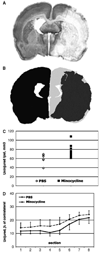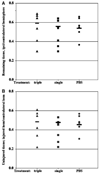Minocycline confers early but transient protection in the immature brain following focal cerebral ischemia-reperfusion
- PMID: 15874975
- PMCID: PMC2262097
- DOI: 10.1038/sj.jcbfm.9600121
Minocycline confers early but transient protection in the immature brain following focal cerebral ischemia-reperfusion
Erratum in
- J Cereb Blood Flow Metab. 2006 Mar;26(3):446
Abstract
The incidence of neonatal stroke is high and currently there are no strategies to protect the neonatal brain from stroke or reduce the sequelae. Agents capable of modifying inflammatory processes hold promise. We set out to determine whether delayed administration of one such agent, minocycline, protects the immature brain in a model of transient middle cerebral artery (MCA) occlusion in 7-day-old rat pups. Injury volume in minocycline (45 mg/kg/dose, beginning at 2 h after MCA occlusion) and vehicle-treated pups was determined 24 h and 7 days after onset of reperfusion. Accumulation of activated microglia/macrophages, phosphorylation of mitogen-activated protein kinase (MAPK) p38 in the brain, and concentrations of inflammatory mediators in plasma and brain were determined at 24 h. Minocycline significantly reduced the volume of injury at 24 h but not 7 days after transient MCA occlusion. The beneficial effect of minocycline acutely after reperfusion was not associated with changed ED1 phenotype, nor was the pattern of MAPK p38 phosphorylation altered. Minocycline reduced accumulation of IL-1beta and CINC-1 in the systemic circulation but failed to affect the increased levels of IL-1beta, IL-18, MCP-1 or CINC-1 in the injured brain tissue. Therefore, minocycline provides early but transient protection, which is largely independent of microglial activation or activation of the MAPK p38 pathway.
Figures




References
-
- Arvin KL, Han BH, Du Y, Lin SZ, Paul SM, Holtzman DM. Minocycline markedly protects the neonatal brain against hypoxic–ischemic injury. Ann Neurol. 2002;52:54–61. - PubMed
-
- Barone FC, Feuerstein GZ. Inflammatory mediators and stroke: new opportunities for novel therapeutics. J Cereb Blood Flow Metab. 1999;19:819–834. - PubMed
-
- Barone FC, Irving EA, Ray AM, Lee JC, Kassis S, Kumar S, Badger AM, White RF, McVey MJ, Legos JJ, Erhardt JA, Nelson AH, Ohlstein EH, Hunter AJ, Ward K, Smith BR, Adams JL, Parsons AA. SB 239063, a second-generation p38 mitogen-activated protein kinase inhibitor, reduces brain injury and neurological deficits in cerebral focal ischemia. J Pharmacol Exp Ther. 2001;296:312–321. - PubMed
-
- Benjelloun N, Renolleau S, Represa A, Ben-Ari Y, Charriaut-Marlangue C. Inflammatory responses in the cerebral cortex after ischemia in the P7 neonatal rat. Stroke. 1999;30:1916–1923. discussion 1923–1914. - PubMed
-
- Bhat NR, Zhang P, Lee JC, Hogan EL. Extracellular signal-regulated kinase and p38 subgroups of mitogen-activated protein kinases regulate inducible nitric oxide synthase and tumor necrosis factor-alpha gene expression in endotoxin-stimulated primary glial cultures. J Neurosci. 1998;18:1633–1641. - PMC - PubMed
Publication types
MeSH terms
Substances
Grants and funding
LinkOut - more resources
Full Text Sources
Medical
Miscellaneous

